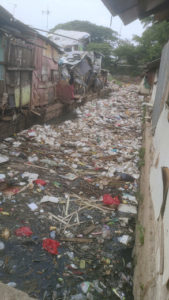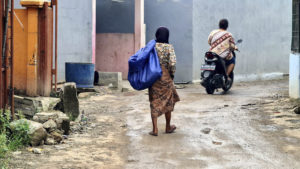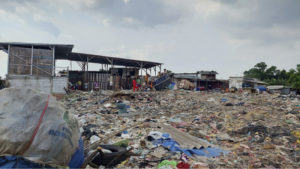“Selamat siang, Kak Anita,” a six-year-old boy calls to me from the field near our house—“Good afternoon, Kak Anita.” His name is Miko,1 and I have known his family since before he was born. His shirt is torn, he goes barefoot, and his hands and feet are dirty. His family makes their livelihood as garbage scavengers, sometimes begging on the streets of Jakarta as well. They join more than one billion people in our world today who live in urban slum communities2—areas that suffer from “inadequate access to water, inadequate access to sanitation and other infrastructure, poor structural quality of housing, overcrowding and insecure residential status.”3
For the past decade, it has been my joy and privilege to get to journey with children like Miko. Today I mourn as I see him, knowing that he already dropped out of our kindergarten program a few months ago. I wonder what possible hope there is for his future, and I pray that more people will follow God’s call to respond to the needs of those in urban slum communities.
―

A canal runs through the slum community where the author and her family make their home. Photo courtesy of the author.
When I graduated from Eastern Mennonite University (Harrisonburg, VA), I thought I was done with academia for a long time. Tired of the classroom, I plunged myself into life in a slum community4 in inner-city Jakarta. Serving with Virginia Mennonite Missions and Servants to Asia’s Urban Poor, I spent the first year as a learner, focusing on language learning and culture learning. I had no clear ideas or agenda about what I could possibly offer in such a complex location as a twenty-two-year-old foreigner. But as time went by, the Lord tugged at my heart and showed me the needs—and the gifts—of the children around me.
Too many children in Indonesia do not have access to kindergarten programs. Government schools start at first grade, and so families who want their children to attend kindergarten must have the money to pay for a private school. Since most of my neighbors in the slum community could not afford kindergarten, they began elementary school significantly behind their peers’ education. Our team, which at the time was made up of myself and two Indonesians, decided that providing elementary school education would be a practical way we could serve the community the Lord had planted us in.
What began as a coloring club grew into a school, called House of Hope, that offers a free kindergarten and afterschool program for elementary school kids in our neighborhood. The school has served about one hundred children a day for the past ten years.
Through House of Hope we have been able to meet hundreds of families (perhaps more than a thousand by now) over the years. Families that primarily make their livelihoods from Jakarta’s trash—collecting garbage and scavenging for recycling—have become our dear friends.5
When joining a new community, it is all too tempting to bring with us power, money, and education that we end up using to disempower those around us. Even if that is not our intention, too often it is what actually happens. Aiming to avoid this common pitfall, House of Hope instead sought to become “alongsiders” (see Craig Greenfield’s new book Subversive Mission6) by inviting three moms from the community to become teachers themselves. One of my great joys over the past three years has been training these women and seeing them become beautiful teachers, despite that fact that they had not even graduated from middle school. Through this teacher education, we are intentionally serving alongside our Muslim neighbors—joining together in our common belief that children in our neighborhood are valuable and longing for a better future for them.
Collaborating with the three moms has been such a positive experience that we plan to continue training more women from the community every year. We hopefully will be able to open up more schools as our teaching capacity increases. Recently, we recruited two new teachers, who formerly were our students in elementary school. It is a joyful thing to watch them become empowered as teachers, to see them coming to believe that they can help the children around them learn to read and write and do basic math.
Education in itself, however, is not the end goal. While it is a beautiful thing to watch children learn to read and write, and we firmly believe this is worthwhile, we also long for our Muslim neighbors to meet Jesus and experience new life in his Kingdom. While we try to live into Kingdom realities through our actions in the classroom at House of Hope, we also try to be alert to opportunities to humbly share about Christ through words. We believe in holistic ministry, both word and deed together.
Over the past decade, House of Hope has given us the opportunity and privilege of visiting hundreds of students and families in their homes. Many of the dwellings are make-shift shacks, pieced together from plywood scraps, with asbestos for roofing. Physically, our students often suffer from sicknesses almost unheard of in North America: typhoid, dengue, dysentery, measles, mumps, rubella, and the list could go on. When students or their parents are sick, we often have the opportunity to pray for healing in Jesus’s name. We share stories about Jesus and his Kingdom, and we pray that the seeds that are sown will one day grow.
Children play on top of a small mountain of garbage. This illegal dump site was shut down by the government a few years ago, and now many new shacks are springing up on top of the old trash. Photo courtesy of the author.

Many neighbors make their livelihoods scavenging for recycling. They often pull carts or carry sacks to put recycling into. Photo by Yosiah (author’s husband).
And engaging with the community has been brutally hard. We have faced heartbreaking situations again and again. Mission teams fall apart. Students drop out. Girls continue to get married underage. The cycles of poverty and oppression continue over and over again, seemingly untouched by our presence here. But we cling to the hope that nothing is in vain. We believe that somehow this work is important. That teaching ABCs and 123s to Muslim children in this particular slum community is very valuable in the eyes of Jesus.
We also believe there are countless opportunities awaiting the church if followers of Jesus would take the risk of asking Jesus to open our eyes and help us step outside of our comfort zones. According to the United Nations 2109 report, the proportion of the urban population living in slums worldwide continues to rise, with estimates that by 2030 three billion people will require adequate and affordable housing.7 Unfortunately, the Western church is largely unaware of this global reality, and thus ministries and missions focused on reaching slum areas are few and far between. If we do read about slums, the statistics can seem overwhelming and hopeless. But each one of those people has a name, a family, a story—and is valuable in the eyes of the Lord.
I believe the Lord is calling more Anabaptists—those who have grown up rooted and grounded in Christ’s love and the vision of God’s shalom for the world—to dare to give their lives in service in slum communities around the world. We must resist, however, the temptation to arrive as “white saviors”; we must come first as learners, looking for where God’s Spirit is already active and at work, and praying for how we can join in that movement. Frequently, providing education can be a wonderful way to bless the community we are living in and to offer hope for future generations. However, we must do so humbly, focusing on how we can partner with the local people around us, empowering and training new teachers from within the community itself. This will have a much greater, longer-lasting impact on the communities we are serving than importing all of the teachers.
There are many “Mikos” in our world today—children literally growing up on top of piles of trash, with little or no access to affordable education. Wherever we are, even in the West, there will always be children slipping through the cracks of educational systems. Can the church dare to be creative, to find new ways to use education in missions? Through afterschool programs, literacy tutoring, or informal kindergarten programs in slum communities, followers of Christ can and are finding unique ways to respond with love to the needs of the children around them. One does not have to have a degree as a teacher (none of the teachers at House of Hope have degrees in education), but one does need a patient, willing heart.
Anita Rahma and her husband and two boys have lived and served in a slum community in Jakarta for the past twelve years. Anita enjoys learning piano, playing in the rain, and devouring Amy Carmichael books. She is the author of Beyond Our Walls: Finding Jesus in the Slums of Jakarta (Littleton, CO: William Carey, 2022). To learn more about the organizations that Anita and her family serve with, see https://servantsasia.org and https://vmmissions.org. You can order Anita’s book at https://missionbooks.org.
Footnotes
All names have been changed.
United Nations Sustainable Development Goal 11: “Make Cities and Human Settlements Inclusive, Safe, Resilient and Sustainable,” United Nations, January 2023, https://unstats.un.org/sdgs/report/2019/goal-11.
Ash Baker, Slum Life Rising: How to Enflesh Hope within a New Urban World (Birmingham, UK: Urban Shalom, 2012), 21.
I use the phrase “slum community” as a descriptive rather than a derogatory term. When speaking Bahasa Indonesia, we use the word kampung, which literally means “village.” However, there is no sugar-coating the distressing physical reality faced by more than a billion people in the world today living in such tenuous housing environments. For lack of a better word, I use this term when speaking English. The United Nations also uses the term “slum” or “informal settlement.”
For years, a mini-mountain of raw trash claimed a spot in our community. It has now been shut down by the government, and new shacks have sprung up on top of what once was trash. These dwellings are safer from floods, but the ground is still squishy.
Craig Greenfield, Subversive Mission: Serving as Outsiders in a World of Need (Downers Grove, IL: InterVarsity, 2022).
United Nations SDG Goals, “Make Cities and Human Settlements Inclusive, Safe, Resilient and Sustainable.”
